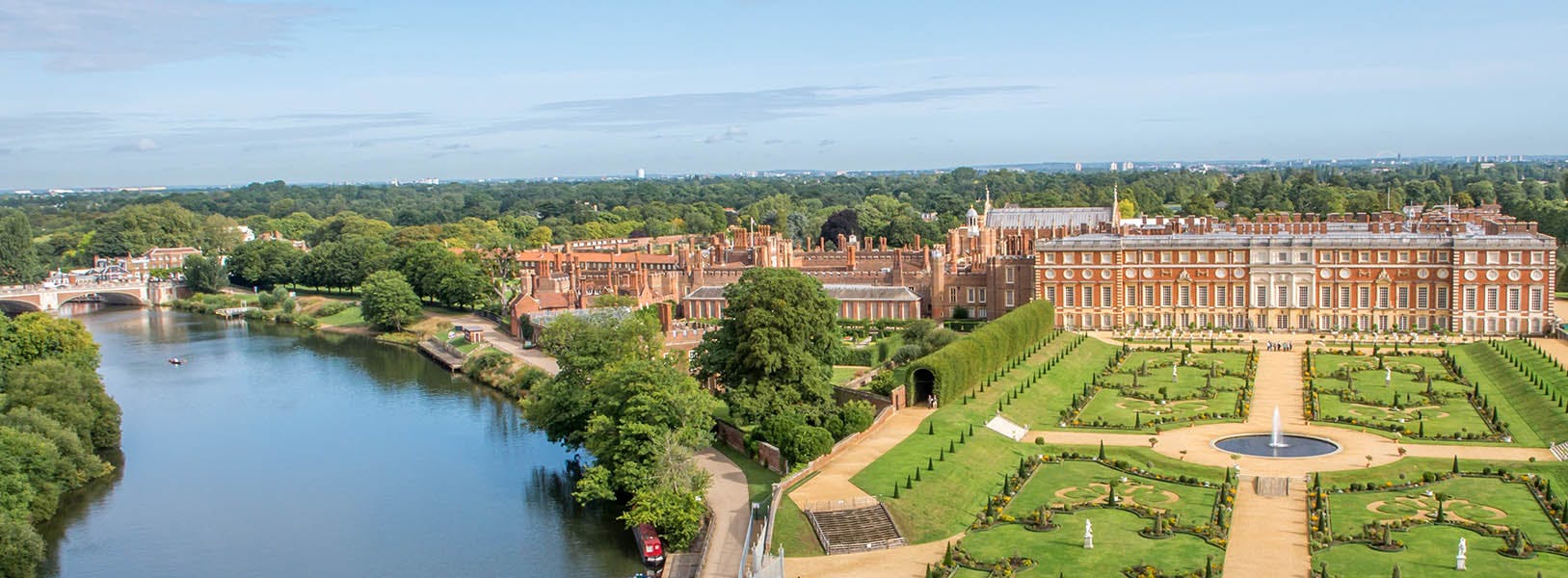
Home of Henry VIII and the Tudor dynasty: a 500-year old royal pleasure palace
The original Tudor Hampton Court Palace was begun by Cardinal Thomas Wolsey in the early 16th century. But it soon attracted the attention of Henry VIII, who brought all his six wives here.
Surrounded by gorgeous gardens and famous features such as the Maze and the Great Vine, Hampton Court Palace has been the setting for many nationally important events.
When William III and Mary II (1689-1702) took the throne in 1689, they commissioned Sir Christopher Wren to build an elegant new baroque palace. Later, Georgian kings and princes occupied the splendid interiors. When the royals left in 1737, impoverished 'grace and favour' aristocrats moved in.
Queen Victoria opened the palace to the public in 1838. It has remained a magnet for millions of visitors, drawn to the grandeur, the Hampton Court ghosts and the fabulous art collection.

Image: An aerial view of Hampton Court Palace © Historic Royal Palaces
Cardinal Wolsey's Tudor Palace
Cardinal Thomas Wolsey, Henry VIII’s Lord Chancellor, started Hampton Court Palace’s transformation from ordinary country house to magnificent palace.
Wolsey wanted to create a grand building where he could host not only the King and the royal court but also monarchs from across Europe.
Investing huge sums of money, he created a palace fit for the King. Wolsey was so successful in his work that Henry eventually took Hampton Court for himself.
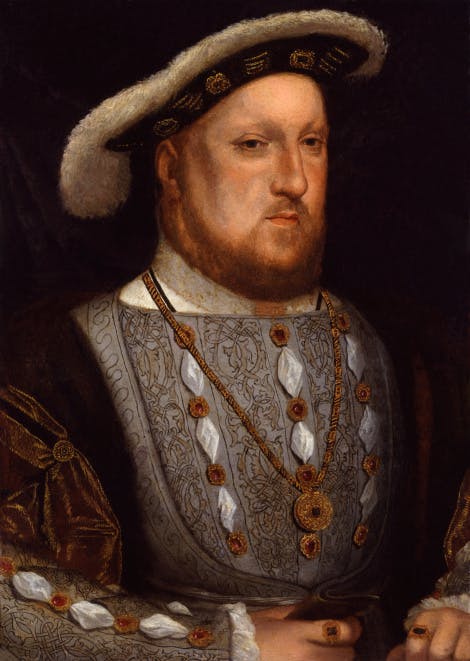
Image: Henry VIII, after Hans Holbein the Younger. © National Portrait Gallery, London.
Home of Henry VIII
By the 1530s, Henry VIII's Hampton Court was a palace, a hotel, a theatre and a vast leisure complex.
The King used it to demonstrate magnificence and power in every possible way, through lavish banquets, extravagant court life and fabulously expensive art.
In addition to Henry’s state and private apartments, where he slept, ate and relaxed, and the queen’s private apartments, the palace contained accommodation for courtiers. The style depended on the status of the occupant, but again, were intended to impress.
Around Base Court, the first big courtyard of the Tudor palace inside the West Front, there were 30 suites of lodgings used for the grandest visitors.
Watch: The early history of Hampton Court, hidden under your feet
Learn more about what the brickwork in Clock Court can tell us about the early Tudor palace with Daniel Jackson, Head of Historic Buildings at Historic Royal Palaces.
This content is hosted on YouTube
This content may be using cookies and other technologies for which we need your consent before loading. To view the content, you need to enable cookies for "Targeting Cookies & Other Technologies".
Manage CookiesDaniel Jackson, Head of Historic Buildings at Historic Royal Palaces, explains the brickwork in Clock Court, the archaeology that led to these discoveries, and how we’re continuing this work today.
Video transcript
Follow along with a transcript of this video on YouTube. A link to the transcript can be found in the description.
Read more: Hampton Court before Henry VIII

Image: Henry VIII, after Hans Holbein the Younger. © National Portrait Gallery, London.
Home of Henry VIII
By the 1530s, Henry VIII's Hampton Court was a palace, a hotel, a theatre and a vast leisure complex.
The King used it to demonstrate magnificence and power in every possible way, through lavish banquets, extravagant court life and fabulously expensive art.
In addition to Henry’s state and private apartments, where he slept, ate and relaxed, and the queen’s private apartments, the palace contained accommodation for courtiers. The style depended on the status of the occupant, but again, were intended to impress.
Around Base Court, the first big courtyard of the Tudor palace inside the West Front, there were 30 suites of lodgings used for the grandest visitors.

Henry VIII's lost gardens at Hampton Court
Discover a vast, glittering complex of lost Tudor buildings
Sorrowful spectres
All of Henry VIII's six wives visited Hampton Court Palace. But the palace also held unhappy memories.
Henry's third queen Jane Seymour died giving the King a longed-for son, Edward, later Edward VI. It’s said her ghost, a ‘white wraith’ appears on the anniversary of her death.
Henry's fifth wife Catherine Howard was arrested here and later executed at the Tower of London for adultery and treason.
Read more: Historic hauntings at Hampton Court Palace

Image: The Great Kitchens. East end, looking south east. © Historic Royal Palaces
The Great Kitchens
Up to 800 courtiers could accompany Henry VIII; all needed to be fed.
The King enlarged and added to the existing Great Kitchen, built in the late 1400s by a former resident Lord Daubeney.
The kitchens became an efficient food factory serving 1600 meals a day.
Read more: Tudor food and eating

Image: The Tudor Great Hall at Hampton Court Palace, showing the Abraham Tapestries and the room set out for day visitors. © Historic Royal Palaces
A playhouse and a prison
The 17th century saw many dramatic events at the palace, some of them taking place in Hampton Court's Great Hall.
In 1603 William Shakespeare's 'King's Men' first performed Hamlet and Macbeth for the new Stuart King, James I. James was also responsible for organising the 1604 Hampton Court Conference that resulted in the publication of the King James Bible in 1611 - the Authorised Version of the Bible in English.
James' son Charles I used the palace to house much of his astonishing art collection, including Mantegna's ‘Triumph of Caesar’ paintings.
Take a look around the Great Hall on our 360-degree image, created in partnership with Google Arts & Culture.
In 1647, Charles found himself under house arrest at Hampton Court after his defeat in the Civil War. The King must have felt a keen sense of irony when his art-adorned palace became his temporary prison.
In an attempt to flee Oliver Cromwell’s Parliamentarians, the King escaped through the Privy Garden. Charles was later recaptured and executed in 1649.
During the Commonwealth (1649-60) Oliver Cromwell saved the palace from destruction by making it his home. Despite his Puritan ideals, he appreciated fine art, particularly the tapestries and enjoyed living like a king here.

Image: The Long Water © Historic Royal Palaces
The Long Water
This beautiful canal was commissioned by Charles II (1660-85) in preparation for the arrival of his bride, Catherine of Braganza. The couple honeymooned at the palace and boats in the shape of swans sailed up the canal in a romantic gesture.
Charles’s principal mistress, Barbara Villiers, Countess of Castlemaine, and their illegitimate children were also installed at Hampton Court. The Countess made changes of her own to the grounds, transforming Henry VIII’s old orchard into a delightful ‘Wilderness’.
Read more: The gardens at Hampton Court Palace

Image: The King's Private Dining Room. This room was used by King William III for small private dinner parties for his male friends. The walls are hung with Kneller’s paintings, ‘Hampton Court Beauties’. © Historic Royal Palaces
A most elegant era
When William III and Mary II took the throne in 1689 they asked Christopher Wren to design a new baroque palace for them. Wren scrapped his original plan to demolish the whole palace and instead created the spectacular Fountain Court, leaving much of the Tudor palace intact.

Image: Aerial view of Great Fountain Garden © Historic Royal Palaces
A lovely landscape
William and Mary were also responsible for creating many of the most spectacular areas of the Hampton Court Gardens to complement their new palace. These include The Great Fountain Garden, created by Daniel Marot, and a new Privy Garden.
The yew trees of the Great Fountain Garden, once neatly pruned, were later allowed to grow to their present height by Capability Brown, head gardener in the mid 18th century.
The Maze
The origins of the famous Maze are controversial, but it is thought it was created at the end of the 17th century.
The Maze was first planted in hornbeam, then replanted in the 1960s with visitor-proof yew hedges. The more authentic hornbeam is now being re-introduced.
Did you know?
When the palace was opened to the public in 1838, the Maze quickly became one of the most popular attractions, and remains so today.

Image: The Chapel Royal, looking south east © Historic Royal Palaces
Queen Anne's Changes
The east end of the Chapel Royal once contained a great double window filled with stained glass, depicting Henry VIII, Katherine of Aragon and Cardinal Thomas Wolsey.
This was destroyed in the Commonwealth and later bricked up.
In 1710 Queen Anne commissioned architect Sir Christopher Wren to remodel the Chapel.
He placed this grand timber reredos (altar screen) over the brickwork.
Wren also added boxed in pews, an organ and a staircase leading down from the Royal Pew.
Read more: Queen Anne

Image: King George I, © National Portrait Gallery, London.
The Georgian Palace
George I's main contribution to the palace was to build an impressive suite of rooms for his son George, Prince of Wales and his wife Princess Caroline.
The King also commissioned a new kitchen, today known as the Georgian House.
When George I returned in the summers to his native Hanover, he agreed reluctantly for the Prince and Princess to represent him in England.
They entertained lavishly in his absence, leading a glittering court that outshone the old King’s.
The infuriated George I tried to outdo this rival court and make a bigger impact at Hampton Court.
So in 1718, the Tudor tennis court was refurbished as a grand assembly room and the Great Hall was converted into a theatre.

Image: The Queen's Stairs at Hampton Court Palace. © Historic Royal Palaces
A Last Flourish
When George II succeeded his father in 1727, the palace entered its final phase as a royal residence.
George and Caroline completed work on their apartments and started new works for the younger members of their large royal family.
In 1734 Queen Caroline invited her favourite architect and designer William Kent to decorate the plain walls of the Queen’s Stairs. He created a Roman-style design, which included a tribute to Caroline, whom he compared to the ancient goddess Britannia.
Take a look around the Queen's Stairs on our 360-degree image, created in partnership with Google Arts & Culture.
Read more: Kings and queens of the Georgian period
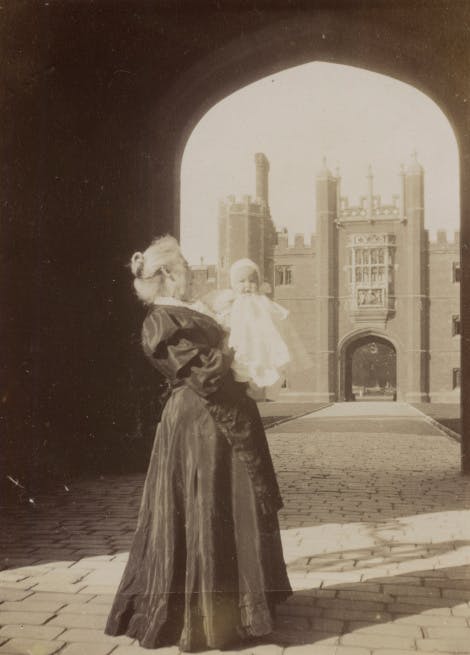
Image: Often characterised as genteel older ladies, the family of grace and favour residents often spanned generations. This is probably Lady Keyes - photographed by her daughter Madeline in 1906. © Historic Royal Palaces/Madeline Keyes
Grace and favour
By 1737, George II no longer wanted to use Hampton Court as a royal palace. It was quickly filled with grace and favour residents.
Many of them were aristocratic widows in straitened circumstances, who were offered free accommodation in return for their husbands’ services to the monarch.
The various apartments, although extremely grand, not always the most comfortable places to live. Residents regularly complained that the palace was 'perishingly cold' and damp, and some had no access to hot water.
Apartments continued to be granted as late as the 1960s.

Image: Stairs to Grace and Favour Apartments © Historic Royal Palaces
My mother lives in a most primitive manner down in that dreary red-brick dungeon at Hampton Court.
Quote from the character Henry Gowan in Little Dorrit, by Charles Dickens.

Image: Illustration depicting visitors strolling by the pond in the Great Fountain Garden. From: 'The Pictorial World', 20 October 1877. © Historic Royal Palaces
'Thrown open to all her subjects'
Queen Victoria opens Hampton Court to the public
In 1838, Queen Victoria ordered the gates of Hampton Court Palace be 'thrown open to all her subjects' as an early act of generosity.
Visitors flocked to enjoy the stunning palace architecture, get lost in the Maze and relax in the beautiful gardens.
By 1881, over ten million visitors had been recorded, a huge number for the time.
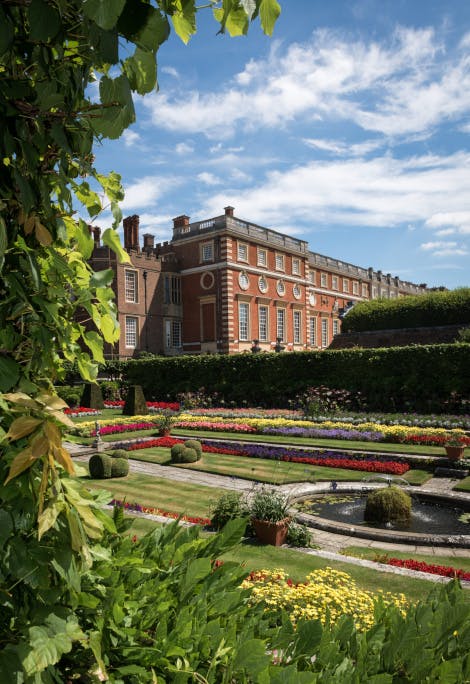
Image: The Pond Gardens, looking north-east towards the South Front © Historic Royal Palaces / James Linsell-Clark
A grand day out
During the Victorian period, Hampton Court Palace was one of the few attractions open on a Sunday, the only day working people had to visit. Visitors arrived by every possible means: from boat to public coach. Their journeys were made easier by the railways arriving at Hampton Court in 1849.
However, this sudden rush was not altogether welcomed by the grace and favour residents who had previously enjoyed exclusive rights to the Hampton Court gardens. They complained that the gardens became ‘hell on earth, the people come intoxicated and the scenes in the gardens on the Lord’s day are beyond description’.
Despite the complaints, the number of visitors rose steadily year on year. The public was eager for novelty, and applauded the gardeners’ effort to put the palace gardens in the forefront of fashion.
Patriotic displays of mass bedding celebrated the coronation of George V in 1911, for example.
In the 1920s, further leisure activities were provided, along with a car park located, rather unattractively on the West Front. Visitors could take tea in the Tiltyard café, enjoy putting on the green or play a game of tennis on the newly installed court.
Discover more about Hampton Court Palace

Explore Henry VIII's Tudor Palace
Virtual Tour
Discover more about Hampton Court Palace during the reign of Henry VIII with our interactive story, created in partnership with Google Arts & Culture.
Browse more history and stories

Thomas Wolsey
Henry VIII’s right-hand man – until the King met Anne Boleyn
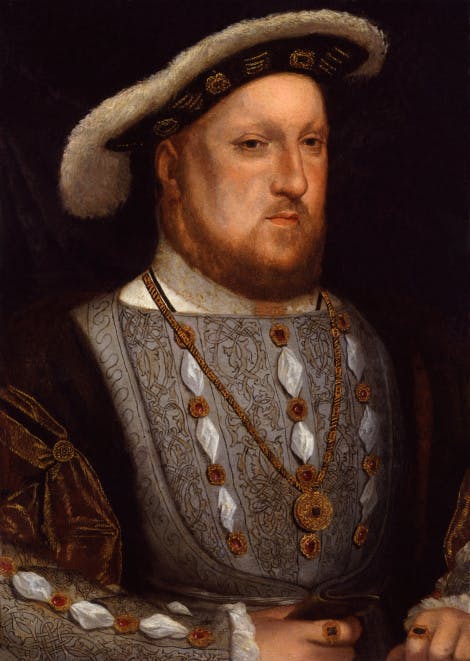
Henry VIII, Terrible Tudor?
Who was the real Henry VIII?
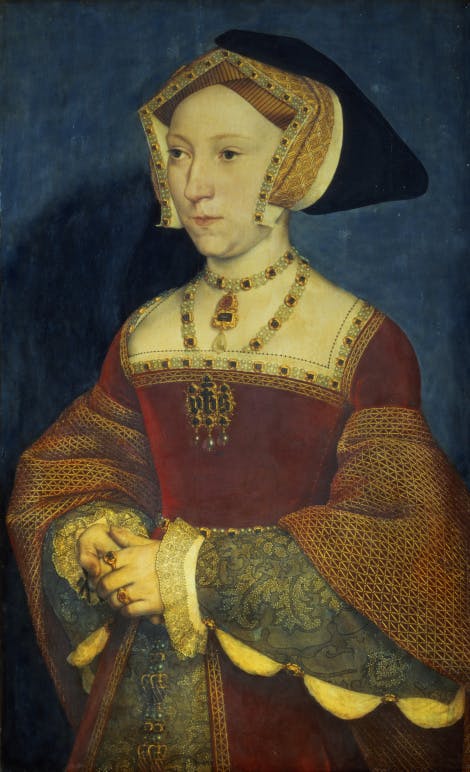
Jane Seymour
Henry VIII's favourite Queen?
Explore what's on

- Families
- Half term
- Things to see
February Half Term
Join a royal quest this half term with Elizabeth I at Hampton Court Palace.
-
14 – 22 February 2026
- 10:00-16:00
- Hampton Court Palace
- Included in palace admission (Members go free)
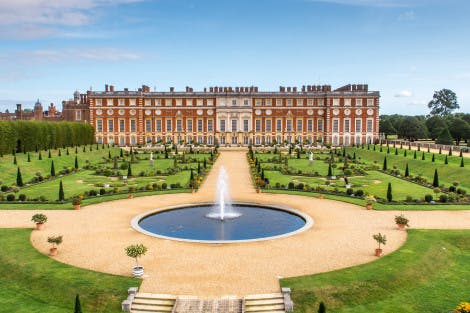
- Things to see
Hampton Court Gardens
Take time to explore and relax in these world-renowned gardens and find our free entry Garden Open Days dates.
- Open
- In line with palace opening hours
- Hampton Court Palace
- Included in palace admission (Members go free)

- Things to see
Kitchen Garden
Experience the recreated Kitchen Garden, which would have fed the Georgian royals and now supplies Henry VIII's Kitchens.
- Open
- In line with palace opening hours
- Hampton Court Palace
- Included in palace admission (Members go free)
Shop online
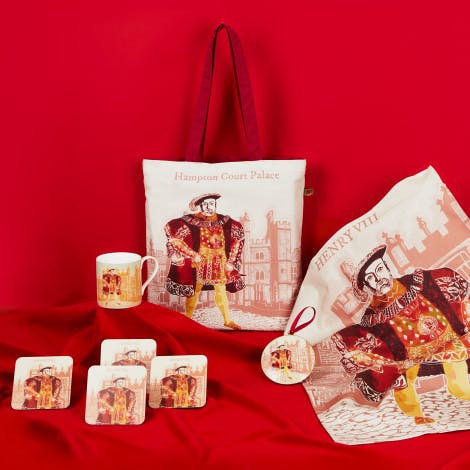
Shop Tudors
Find the perfect gift for collectors and history enthusiasts in our treasure trove of souvenirs inspired by this ever-fascinating dynasty.
From £3.00

Shop Goblets & Tankards
Discover our decadent range of goblets and tankards inspired by the palaces in our care, the perfect gift for any history fan.
From £10.00
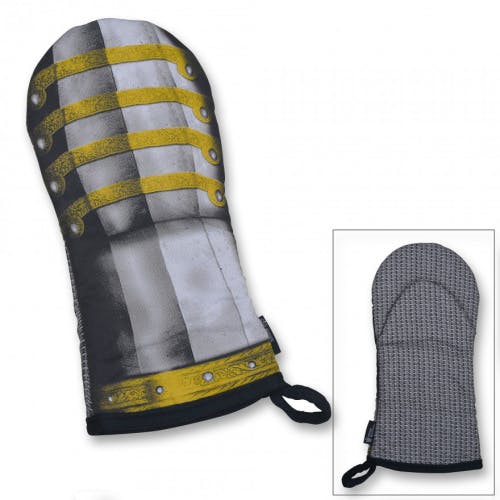
Henry VIII Gauntlet Armour Oven Glove
This fun oven glove is inspired by a suit of armour made for Henry VIII in 1540, currently on display at the Tower of London.
£18.00
